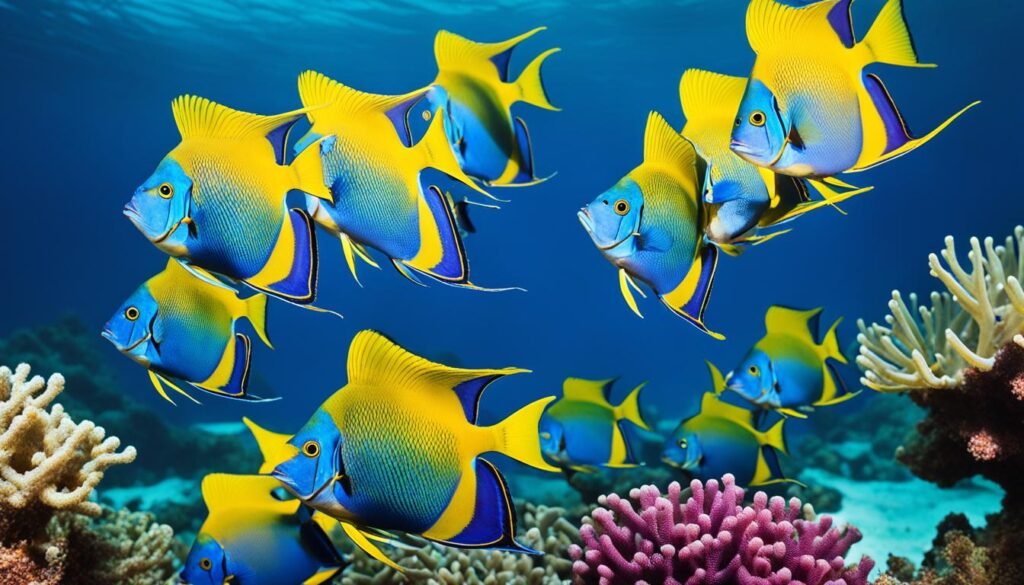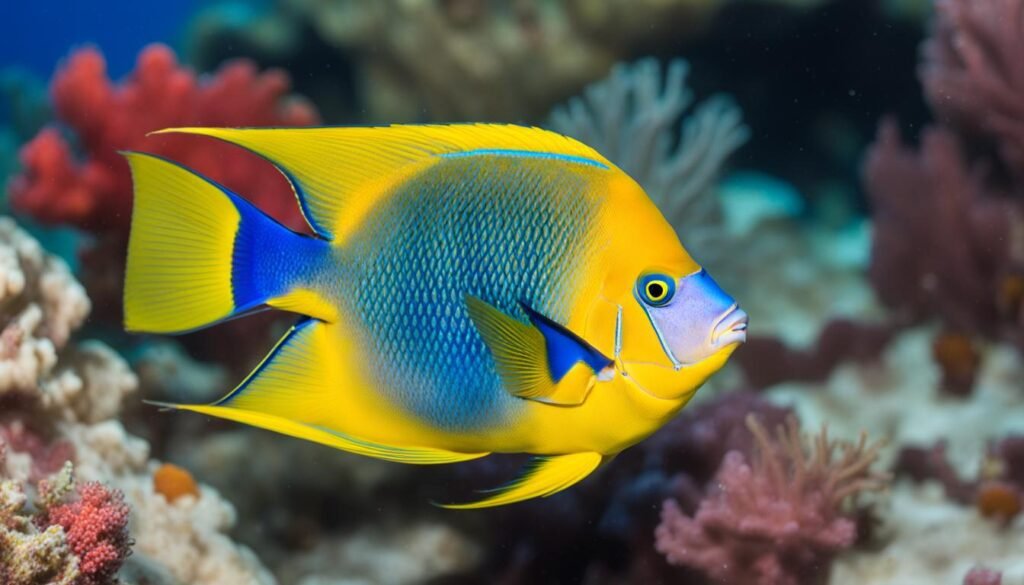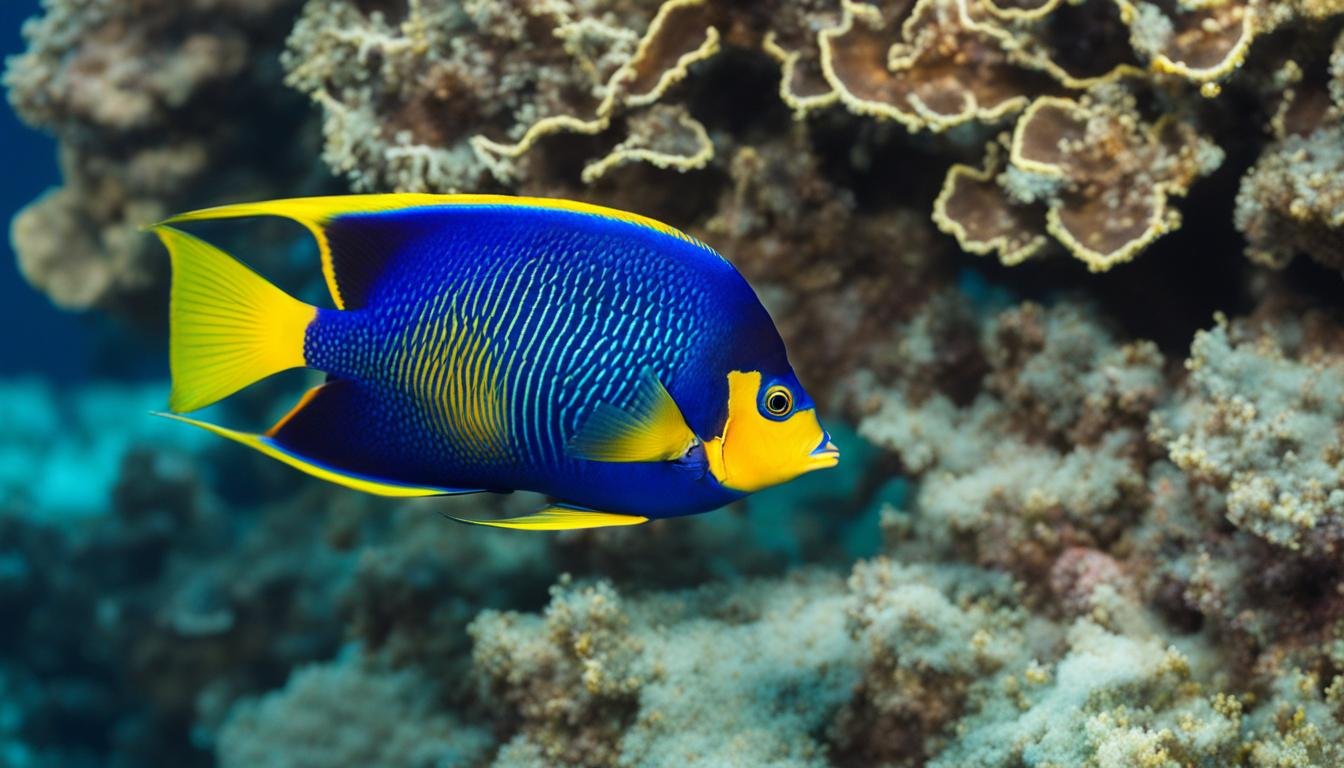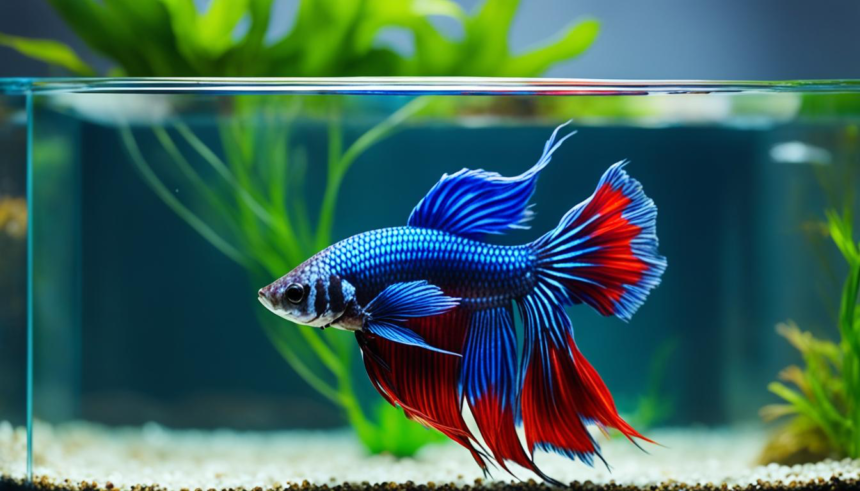Queen angelfish are as majestic as their name implies, drawing eyes in both reef habitats and aquariums. They show a range of behaviors, mixing aggression, grace, and teamwork in the ocean. Understanding these behaviors is key for their care in aquariums.
However, queen angelfish can also show dominance, affecting the peace of their surroundings. It’s important to know their temper, especially regarding aggression, in both the wild and aquariums. By exploring their social interactions, we learn how they fit into reef ecosystems and man-made tanks.
Introducing the Queen Angelfish: Holacanthus ciliaris
The queen angelfish, or Holacanthus ciliaris, is a stunning sea jewel. It draws attention from marine lovers and researchers. With its bright blues and yellows, it showcases the sea’s natural beauty. These fish add a splash of color to the Western Atlantic.
Identifying the Queen Angelfish in the Wild
Seeing a queen angelfish is a treat. They have a unique look with electric blue and golden edges. This look, along with their elegant fins, makes them easily recognizable in their reef homes.
The Queen Angelfish’s Habitat in the Western Atlantic
The queen angelfish calls the Western Atlantic home. The area’s coral reefs provide warmth and shelter. These reefs are vital for their survival.
Physical Characteristics: Coloration and Fin Structure
The queen angelfish’s fin design is fascinating. Their fins help them swim smoothly through the reefs. They have long dorsal and anal fins. These fins trail behind elegantly as they move.
Their color changes as they grow. Young ones have blue circles. As they mature, their colors turn into the majestic patterns we recognize.
| Feature | Description |
|---|---|
| Scientific Name | Holacanthus ciliaris |
| Habitat | Western Atlantic coral reefs |
| Adult Coloration | Deep blue body edged in brilliant yellow |
| Fin Structure | Long, tapering dorsal and anal fins with filaments |
| Size Range | Up to 18 inches in length |
Queen Angelfish Social Dynamics

People love the queen angelfish for its bright colors and complex social dynamics. They display a remarkable hierarchy among themselves. This ranking is vital, as it affects who mates and gets the best resources.
Their behavior and territoriality are closely linked. Queen angelfish show strong territorial behavior. This is true both in the wild and in aquariums. They pick a specific part of the reef as their area. Then, they protect it from others, sometimes putting on quite a show to keep their rank.
- Establishment of a dominant male’s territory.
- Delineation and defense of territories among the species.
- Pairing and reproductive rights linked to hierarchy standings.
Learning about these behaviors is fascinating and useful for aquarium enthusiasts. Knowing these can help them make a peaceful home for queen angelfish. Watching these actions closely aids in managing the tank and avoiding fights over space.
| Behavior | Implication | Observation in Captivity |
|---|---|---|
| Aggression Displays | Maintaining territory | Increased with limited space |
| Pair Bonding | Hierarchy influence on mating | Compatibility with dominant individual needed |
| Feeding Hierarchy | Access to resources | Requires strategic feeding practices |
Queen Angelfish Interactions in the Aquarium Setting
Adding a queen angelfish to your aquarium is thrilling. But, understanding their needs is crucial for a healthy tank. Here’s what you need to know about bringing these beautiful fish into your home aquarium.
Creating a Compatible Community Aquarium
Starting a tank with a queen angelfish means picking the right tank mates. They must get along and have similar needs. This way, your angelfish can live peacefully without stress.
- Research prospective tank mates thoroughly.
- Avoid other large, territorial fish that may compete with the queen angelfish.
- Opt for species that thrive in similar water conditions.
Impact on Invertebrates and Smaller Fish
Queen angelfish sometimes eat smaller fish and invertebrates. So, pick these tank mates carefully.
| Species | Compatibility with Queen Angelfish | Risk Level |
|---|---|---|
| Shrimp | Moderate | Medium |
| Snails | High | Low |
| Crabs | Moderate | Medium |
| Smaller Fish | Low | High |
The Importance of a Spacious Saltwater Environment
A big tank is vital for the queen angelfish. It supports their natural behavior and helps avoid fights over territory. Here are some tips to keep them happy and healthy.
- Provide a minimum of 100 gallons of water for adult queen angelfish.
- Ensure plenty of vertical space for swimming.
- Include rockwork and hiding places to simulate a natural reef structure.
Queen Angelfish Feeding Habits and Reproduction

The stunning queen angelfish is a spectacle for the eyes. They have intriguing feeding and reproductive behaviors. To fully appreciate these creatures, one must explore their daily and life routines.
Feeding Habits: From Plankton to Sponges
The diet of queen angelfish is as vibrant as they look. These marine beauties eat various things from their reef home. Their feeding habits include looking for plankton in warm waters. They also nibble on sponges with their special mouths. This varied diet supports their bright colors and energy needs.
Cleaning Stations and Symbiotic Relationships
Queen angelfish often visit cleaning stations. Here, they work with species like cleaner shrimps and wrasses. At these stations, they are cleaned of parasites and dead skin. This helps their health and the ocean’s balance. It shows how angelfish help in marine life’s interconnections.
Reproduction: Spawning and Larval Development
The reproduction of queen angelfish is amazing. During spawning, females release eggs, and males fertilize them in water. After fertilization, larval development starts. Initially, larvae drift in ocean currents. Then, they settle in reefs as juveniles.
| Life Stage | Diet | Behavior |
|---|---|---|
| Larvae | Microalgae, zooplankton | Drifting in open water |
| Juvenile | Plankton, sponges, and algae | Seeking shelter in reefs |
| Adult | Sponges, tunicates, and algae | Visiting cleaning stations, spawning |
With their complex feeding habits and reproductive strategies, queen angelfish are vital to their ecosystems. They add to the beauty of marine life. Their existence shows why we need to protect our oceans for all marine species’ futures.
Conclusion
The beauty and importance of the queen angelfish can’t be overstated. They show a range of behaviors crucial to both reef and aquarium worlds. Their social habits, eating patterns, and ways of reproducing are complex. Understanding these aspects is key for people who keep fish and love the sea.
Queen angelfish are vital to the community of the reef. Their interactions play a big role in marine life balance. In aquarium environments, it’s important to create a space that feels like their natural home. This helps them act naturally and stay healthy.
- Social Dynamics: The social dynamics of queen angelfish include important group behaviors and setting up territories.
- Feeding Habits: They mostly eat sponges and algae. This diet needs special attention when they live in tanks.
- Reproduction: Their reproduction method requires the right environment for the eggs to be successfully laid in tanks.
| Aspect | Reef Habitats | Aquarium Environments |
|---|---|---|
| Social Structure | Defined territories driven by ecological factors | Mimicking natural hierarchies to reduce stress |
| Feeding Preferences | Natural sources of sponges and tunicates | Specially formulated diets to replicate reef nutrition |
| Reproductive Behavior | Spawning tied to lunar cycles and water conditions | Controlled environments for fostering egg-laying |
In summary, providing a natural-like behavior setting for queen angelfish is crucial. It enriches their life and helps us understand these splendid fish. It’s essential for both protecting these fish and improving aquarium settings.
Frequently Asked Questions (FAQ)
Aquarists and marine lovers want to know about the queen angelfish. They ask about its behavior, what it eats, if it can live in reef tanks, and how it reproduces. We’ll answer these questions to help you understand these beautiful, complex sea creatures better.
Are queen angelfish aggressive towards other fish?
Queen angelfish can be aggressive, especially towards smaller or similarly shaped fish. Pairing them with the right tankmates helps avoid fights and keeps the peace in your aquarium. Giving them enough space and things to explore also helps prevent aggression.
Can queen angelfish be kept in a reef aquarium?
Keeping queen angelfish in a reef tank is tricky because they nibble on corals and invertebrates. But with careful monitoring and choosing the right tankmates, you can have a beautiful reef tank with queen angelfish. It takes effort but is possible.
What do queen angelfish eat in the wild?
In their natural habitat, queen angelfish have a diverse diet. They eat sponges, plankton, and other sea plants. Their eating habits show the rich variety of life in their coral reef homes.
How do queen angelfish reproduce?
Queen angelfish reproduce by spawning. Females release eggs into the water for males to fertilize. The eggs quickly hatch into larvae. These larvae feed on plankton until they grow into juveniles. These juveniles eventually develop into the colorful adults queen angelfish are famous for. This process shows the circle of life for these fish.
Learn More..
Is king mackerel a good fish to eat?
FAQ
Are queen angelfish aggressive towards other fish?
Yes, queen angelfish can be aggressive. They may pick on smaller fish and others of their size. It’s vital to choose tankmates wisely to keep peace and reduce fighting.
Can queen angelfish be kept in a reef aquarium?
Keeping queen angelfish in a reef aquarium can be tough. They tend to nip at invertebrates and coral. But, with close watch and choosing the right tankmates, they can fit into reef environments.
What do queen angelfish eat in the wild?
In the wild, queen angelfish eat a lot of different things. Their diet includes plankton, sponges, and algae. They grab whatever food they find around them.
How do queen angelfish reproduce?
Queen angelfish lay fertilized eggs through spawning. These eggs turn into larvae. Then, the larvae eat plankton until they grow up and look like adults.













